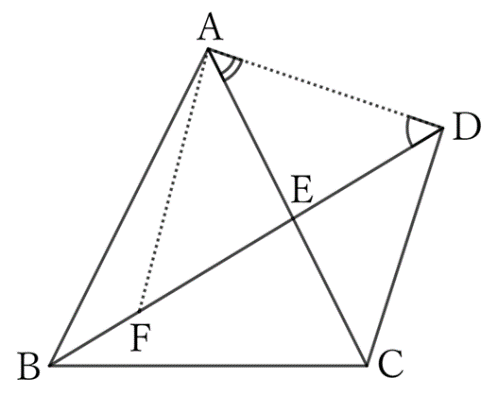Problem
Create two triangles $△ABC$ and $△DBC$ on the same side of the same base $BC$.
Suppose that
$$AB+AC=DB+DC, \quad AB=AC \quad and \quad DB>DC.$$
If the intersection of $DB$ and $AC$ is $E$, then
$$AE>DE.$$
$$ $$
$$ $$
$\downarrow$ $\downarrow$ $\downarrow$ $\downarrow$ $\downarrow$
$$ $$
$$ $$
$$ $$
$$ $$
$$ $$
$$ $$
$$ $$
$$ $$
$$ $$
$$ $$
Solution

If we take $DF$ equal to $AC$ on $DB$, then from $AB+AC=DB+DC$ and $DF=AC$,
$$AB=BF+DC,$$
$$∴ \ AB-BF=DC. \qquad [1]$$
Regarding $△ABF$, from the problem $0042$,
$$AB-BF<AF. \qquad [2]$$
From $[1]$ and $[2]$,
$$AF>DC. \qquad [3]$$
Regarding $△ADF$ and $△DAC$, they are on the same side of the base $AD$, $DF=AC$, and $[3]$.
Thus, from the problem $0041$,
$$∠ADF>∠DAC,$$
$$∴ \ ∠ADE>∠DAE. \qquad [4]$$
Therefore, from the problem $0039$,
$$AE>DE.$$
$ $
Reference
Teiichiro Sasabe (1976) The Encyclopedia of Geometry (2nd edition), Seikyo-Shinsha, p.14